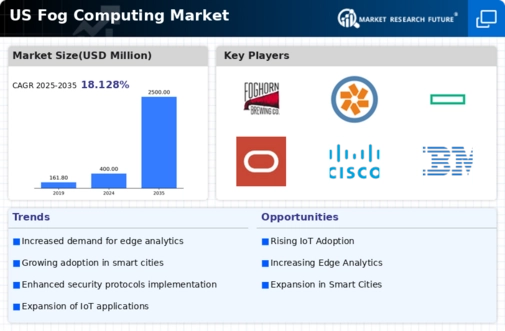The competitive landscape of the US Fog Computing Market is characterized by rapid technological advancements and increasing demand for edge computing solutions. As organizations aim to improve data processing capabilities while reducing latency, several companies are emerging as key players, offering innovative services and products tailored to the unique needs of clients across various industries. The market is marked by collaborations, acquisitions, and strategic partnerships as firms strive to enhance their offerings and expand their market presence.
With the integration of Internet of Things technologies in existing systems, companies in this sector are actively working to address the challenges posed by data volume and processing requirements, focusing on delivering faster and more efficient solutions that cater to specific operational needs.FogHorn has established itself as a notable contender in the US Fog Computing Market through its focus on edge intelligence. By providing robust solutions that allow organizations to analyze data in real-time at the source, FogHorn enables businesses to enhance operational efficiency and decision-making processes.
Its platform is designed to support a variety of industrial applications, particularly in manufacturing, energy, and smart cities, distinguishing the company with its specialized focus. The company's strength lies in its capability to provide powerful analytics and machine learning tools at the edge, which allows clients to derive actionable insights with minimal latency.
FogHorn’s strategic positioning in the market emphasizes its commitment to innovation and customer-centric solutions, providing it with a competitive edge against other players striving to meet the burgeoning demand for effective fog computing technologies.Pivotal is also a significant player in the US Fog Computing Market, recognized for its comprehensive suite of cloud-native platforms and services that enhance application development and data management at the edge. Their key products cater to various industries, integrating seamlessly with existing systems to empower organizations to leverage their data and optimize workflows.
Pivotal’s strength is amplified through its rich service offerings that include cloud-native application development, data services, and analytics capabilities, all designed to meet the specific needs of US enterprises. The company maintains a solid market presence, bolstered by strategic mergers and acquisitions that enhance its technological capabilities and broaden its service offerings. By aligning with industry leaders and focusing on digital transformation solutions, Pivotal successfully positions itself as a crucial contributor to the evolving landscape of fog computing in the US, providing organizations with cutting-edge tools to harness the potential of their data effectively.























